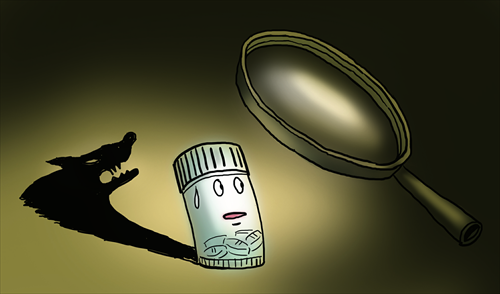HOME >> OP-ED
Blaming China oversimplifies real sources of global counterfeit menace
By Mark Kapchanga Source:Global Times Published: 2014-4-15 20:48:02

Illustration: Liu Rui/GT
The spread of counterfeit products has become a global problem in recent years. The range of goods exposed to infringement is increasing, while the illicit trade itself is turning out to be a complex issue to tackle.
Statistics show that counterfeit goods make up 5 percent to 7 percent of world trade. The figure might be higher due to the secretive nature of the business.
Early this month, French customs seized a stash of 10 tons of fake aspirin and erectile dysfunction and diarrhoea drugs, allegedly from China. This was billed as the EU's biggest ever seizure of counterfeit medicine.
A report released recently by the UN Office on Drugs and Crime claimed that almost 70 percent of all counterfeits seized globally between 2008 and 2010 came from China. On the other hand, in the same period, the US Customs alleged that 87 percent of the value of counterfeits seized originated in China.
China is the world's largest manufacturing workshop. It is also the world's leading exporter. Indeed, about 70 percent of Chinese exports are made up of manufactured goods.
As a manufacturing powerhouse with astonishingly low production cost, strong supply base, high investment in port, road, and rail infrastructure, as well as solid engineering and technical skills, supply chains for many Western companies stretch throughout China.
Such an expanded chain has seen massive leaks of legitimate products, creating a fertile ground for the production of counterfeits.
The link between counterfeits, and their origin, presumably China, is scarring Chinese businesses abroad. Today, any product seen to have been made in China, whether genuine or fake, is exposed to keen market scrutiny. This gives products from other platforms undue advantages.
But it is reassuring that Chinese authorities are proactively fighting the menace. Reports show they have conducted raids and seizures, shutting down illicit factories. In 2011, for instance, the Chinese government conducted a year-long enforcement drive, arresting thousands of suspected counterfeiters. A number of factories, too, were closed in the process. This was followed by a similar effort in 2012.
However, the battle against this crime might not be won anytime soon. The illicit trade is turning out to be more complex every day. Even with the strong and perhaps more effective intellectual property protection methods being developed globally, counterfeiters are breaking through these controls.
Manufacturing techniques have become increasingly sophisticated. Everything from electrical products to software and antibiotics are being counterfeited.
Africa has become the dumping ground for the world's copycats. The World Health Organization says 30 percent of medicines sold in developing countries are fakes. In fact, about 100,000 deaths a year in Africa are linked to the counterfeit drug trade. Globally, 700,000 deaths a year are caused by fake malaria and tuberculosis drugs.
In some African countries, particularly Kenya, Zimbabwe, Ghana and Nigeria, local traders are using the "opportunity" to manufacture more fakes, with labels clearly marked "Made in China." The fake products manufactured locally are then well packaged and clearly labeled and resold to wholesalers as goods imported from China. The multibillion dollar ventures are run by well-oiled, well-connected businessmen that local authorities don't dare arrest.
Unscrupulous businesses in other parts of the world such as Europe and the US are also tirelessly using the unanimous assumption that all fakes come from China to manufacture substandard goods, mainly electronics, which are then dumped in developing countries.
The US, which vehemently tends to blame other regions of generating counterfeit goods, has a rich history of the underground trade. For instance, it is estimated that there are 70 million counterfeit dollars in circulation.
Africa cannot fight this menace on its own. The US cannot keep blaming China for the rise of counterfeit products. It is inevitable that these global powers must unite, and brutally battle this forbidden trade.
Companies manufacturing goods, too, need to introduce more robust and secure technology to protect their products. They should also monitor the supply chain and raise consumer awareness.
The author is a journalist on African issues based in Nairobi, Kenya. mkapchanga@gmail.com
Posted in: Viewpoint